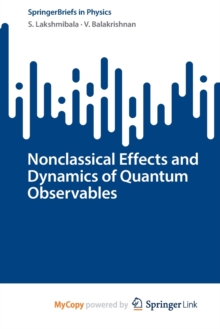Chap. 1. Introduction
1.1 Preamble
1.2 States of light
1.3 Tomograms and state reconstruction
Snapshot summary of Chap. 1: Introduction to nonclassical effects-wave packet revival phenomena, squeezing and entanglement. Ehrenfest relations for quantum observables with nonlinear Hamiltonians. Moment expansion and non-commutativity. Importance of quantum optics models in the study of nonclassical effects. Different states of radiation. Usefulness of tomograms. Optical tomograms and qubit tomograms.
Chap. 2. Revivals, Fractional Revivals and Tomograms
2.1 Introduction
2.2 Basic mechanism of wave packet revivals
2.3 An illustrative example
2.4 Manifestation of revivals in expectation values of observables
2.5 Effect of an imperfectly coherent initial state
2.6 Revivals in single-mode systems: A tomographic approach
2.7 Decoherence effects
2.8 Double-well BEC system: A tomographic approach
Snapshot summary of Chap. 2: Signatures of revivals and fractional revivals in appropriate tomograms corresponding to single-mode and bipartite systems are examined. It is also demonstrated how moments of observables reflect the revival phenomena at specific instants of time during the temporal evolution of a wave packet of radiation in a given initial quantum state, as it propagates in a nonlinear atomic medium.
Chap. 3. Tomographic Approach to Squeezing
3.1 Introduction
3.2 Quadrature squeezing from optical tomograms
3.3 Tomographic entropic squeezing
3.4 Spin squeezing from qubit tomograms
3.5 Higher-order squeezing in single-mode states of light
3.6 Two-mode squeezing
Snapshot summary of Chap. 3: Brief review of quadrature squeezing, spin squeezing and tomographic entropic squeezing. Extraction of squeezing properties from the relevant tomograms, illustrated for single-mode and two-mode systems.
Chap. 4. Entanglement at Avoided Level Crossings
4.1 Entanglement measures and tomographic entanglement indicators
4.2 Entanglement at avoided energy-level crossings
4.3 Tomographic assessment of entanglement in continuous-variable systems
4.4 Bipartite entanglement in multipartite hybrid quantum systems
Snapshot summary of Chap. 4: Review of tomographic entanglement indicators (EIs). Avoided energy-level crossings and chaos. Assessment of entanglement in models of bipartite continuous-variable (CV) systems: (i) a multilevel atom interacting with radiation, (ii) BEC in a double well. Bipartite entanglement in hybrid quantum (HQ) systems-the Tavis-Cummings model.
Remark applicable to both Chap. 4 and Chap. 5: There is, of course, an exhaustive literature on entanglement, but not on the detection and assessment of the extent of entanglement from tomograms. The relevant literature will be cited and discussed.
Chap. 5. Entanglement in time-evolving bipartite systems
5.1 Introduction
5.2 Comparison of EIs in continuous-variable systems
5.3 Comparison of EIs in hybrid quantum systems
5.4 IBM Quantum Platform: Computation of entanglement
5.5 Time series analysis for comparing EIs
Appendix: Brief review of time series analysis
Snapshot summary of Chap. 5: Time dependence of entanglement in CV systems. Examples: (i) a multilevel atom interacting with radiation, (ii) double-well BEC. Assessment of EIs using time series analysis.
Remark applicable to Chap. 5 and Chap. 6: There is exhaustive literature on time series analysis and network analysis, but not on applications of these to quantum obse

